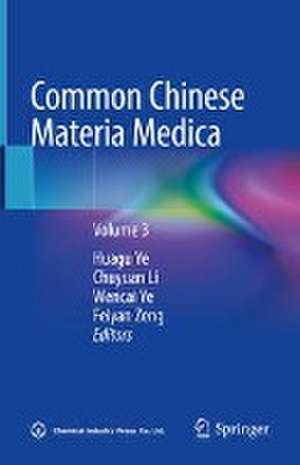Common Chinese Materia Medica: Volume 3
Editat de Huagu Ye, Chuyuan Li, Wencai Ye, Feiyan Zengen Limba Engleză Hardback – 2 dec 2021
In each specie, it introduces the scientific names, medicinal names, morphologies, habitats, distributions, acquisition and processing methods of these medicinal plants, the content of medicinal properties, therapeutic effects, usage and dosage of these medicinal plants, and attaches unedited color pictures and pictures of part herbal medicines of each species. This book series has 10 volumes in total, which covers over 2000 kinds of Chinese medicines that are commonly used. These volumes not only introduce the efficacy function and some prescriptions of the medicines, but also introduce the biological characteristics of them in detail with clear photos of the habitats, so that readers can identify them in the field. Apart from the growing environment, the books expound the distribution areas and other information to facilitate researches and other applications. The volumes are targeted at readers of general interests and it is also of high referential value for scientific researcher and teachers. It can be used as a guide to researchers, clinical doctors, and students in the department of pharmaceutics and traditional Chinese medicine.
Preț: 1058.25 lei
Preț vechi: 1113.95 lei
-5% Nou
Puncte Express: 1587
Preț estimativ în valută:
202.56€ • 220.10$ • 170.26£
202.56€ • 220.10$ • 170.26£
Carte disponibilă
Livrare economică 31 martie-14 aprilie
Preluare comenzi: 021 569.72.76
Specificații
ISBN-13: 9789811658792
ISBN-10: 981165879X
Pagini: 563
Ilustrații: XXII, 563 p. 766 illus., 402 illus. in color.
Dimensiuni: 155 x 235 mm
Greutate: 1.09 kg
Ediția:1st ed. 2021
Editura: Springer Nature Singapore
Colecția Springer
Locul publicării:Singapore, Singapore
ISBN-10: 981165879X
Pagini: 563
Ilustrații: XXII, 563 p. 766 illus., 402 illus. in color.
Dimensiuni: 155 x 235 mm
Greutate: 1.09 kg
Ediția:1st ed. 2021
Editura: Springer Nature Singapore
Colecția Springer
Locul publicării:Singapore, Singapore
Cuprins
Aquilaria sinensis and Daphne genkwa of Thymelaeaceae.- Benincasa hispida, Siraitia grosvenorii, Trichosanthes kirilowii and Trichosanthes rosthornii of Cucurbitaceae.- Camellia sinensis of Theaceae.- Cleistocalyx operculatus, Eugenia caryophyllata and Rhodomyrtus tomentosa of Myrtaceae.- Osbeckia chinensis of Melastomataceae.- Quisqualis indica and Terminalia chebula of Combretaceae.- Hypericum japonicum of Hypericaceae.- Microcos paniculata of Tiliaceae.- Hibiscus mutabilis of Malvaceae.- Croton crassifolius, C. lachnocarpus, C. tiglium, Euphorbia humifusa, E. lathyris, E. pekinensis, Phyllanthus emblica and Sauropus spatulifolius of Euphorbiaceae.
Notă biografică
Editor Huagu Ye is a professor from South China Botanical Garden, Chinese Academy of Sciences, Guangzhou, China.
Editor Chuyuan Li is from Guangzhou Pharmaceutical Holdings Limited, Guangzhou, China.
Editor Wencai Ye is a professor from the College of Pharmacy, Jinan University, Guangzhou, China.
Editor Feiyan Zeng is from South China Botanical Garden, Chinese Academy of Sciences, Guangzhou, China.
Editor Chuyuan Li is from Guangzhou Pharmaceutical Holdings Limited, Guangzhou, China.
Editor Wencai Ye is a professor from the College of Pharmacy, Jinan University, Guangzhou, China.
Editor Feiyan Zeng is from South China Botanical Garden, Chinese Academy of Sciences, Guangzhou, China.
Textul de pe ultima copertă
This third volume describes 226 species of 32 families of medicinal plants, which are commonly used in Chinese medicine. The most important species are Aquilaria sinensis and Daphne genkwa of Thymelaeaceae; Benincasa hispida, Siraitia grosvenorii, Trichosanthes kirilowii and Trichosanthes rosthornii of Cucurbitaceae; Camellia sinensis of Theaceae; Cleistocalyx operculatus, Eugenia caryophyllata and Rhodomyrtus tomentosa of Myrtaceae; Osbeckia chinensis of Melastomataceae; Quisqualis indica and Terminalia chebula of Combretaceae; Hypericum japonicum of Hypericaceae; Microcos paniculata of Tiliaceae; Hibiscus mutabilis of Malvaceae; Croton crassifolius, C. lachnocarpus, C. tiglium, Euphorbia humifusa, E. lathyris, E. pekinensis, Phyllanthus emblica and Sauropus spatulifolius of Euphorbiaceae.
In each specie, it introduces the scientific names, medicinal names, morphologies, habitats, distributions, acquisition and processing methods of these medicinal plants, the contentof medicinal properties, therapeutic effects, usage and dosage of these medicinal plants, and attaches unedited color pictures and pictures of part herbal medicines of each species.
This book series has 10 volumes in total, which covers over 2000 kinds of Chinese medicines that are commonly used. These volumes not only introduce the efficacy function and some prescriptions of the medicines, but also introduce the biological characteristics of them in detail with clear photos of the habitats, so that readers can identify them in the field. Apart from the growing environment, the books expound the distribution areas and other information to facilitate researches and other applications. The volumes are targeted at readers of general interests and it is also of high referential value for scientific researcher and teachers. It can be used as a guide to researchers, clinical doctors, and students in the department of pharmaceutics and traditional Chinese medicine.
In each specie, it introduces the scientific names, medicinal names, morphologies, habitats, distributions, acquisition and processing methods of these medicinal plants, the contentof medicinal properties, therapeutic effects, usage and dosage of these medicinal plants, and attaches unedited color pictures and pictures of part herbal medicines of each species.
This book series has 10 volumes in total, which covers over 2000 kinds of Chinese medicines that are commonly used. These volumes not only introduce the efficacy function and some prescriptions of the medicines, but also introduce the biological characteristics of them in detail with clear photos of the habitats, so that readers can identify them in the field. Apart from the growing environment, the books expound the distribution areas and other information to facilitate researches and other applications. The volumes are targeted at readers of general interests and it is also of high referential value for scientific researcher and teachers. It can be used as a guide to researchers, clinical doctors, and students in the department of pharmaceutics and traditional Chinese medicine.
Caracteristici
Includes almost all of the traditional medicines commonly used in China Covers the trait functions and their medical uses The same structure and figure layout in each medicinal herb
